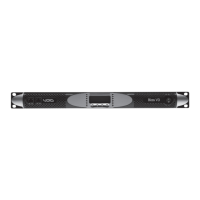10.3 AESOP forward mode
When the amplifier is set in forward mode, the AES3 signal
coming into the amplifier from the AES3-XLR connector is
forwarded to both of the primary RJ45 ports.
The rear panel toggle button near to the channel 2 XLR
connector must be in the “AES/EBU” position. There are
three ways the AES can be forwarded: forward to AES3-A,
forward to AES3-B, forward to both.
10.3.1 Forward to AES3-A
The amplifier’s AES3-XLR connector will be routed to the
AES3-A stream on both primary PORT 1 and 2 (FIGURE 36).
If there is an AES3-B stream incoming from either primary
RJ45 ports (1 or 2), this will be repeated on the other primary
port (FIGURE 39).
10.3.2 Forward to AES3-B
The amplifier behaves just as in the forward to AES3-A
mode but with respect to the AES3-B stream. The AES3-
XLR stream will be routed to the AES3-B stream on both
primary PORTS 1 and 2 (FIGURE 37). The AES3-A stream, if
present will be repeated from/to primary RJ45 ports 1 and 2.
10.3.3 Forward to both
The amplifier’s AES3-XLR stream will be routed to both
AES3-A and AES3-B streams on both primary PORTS 1
and2 (FIGURE 38).
Repeater functionality will be disabled.
IMPORTANT: In any forward mode, the amplifier
can accept as the sole AES3 input signal the
one coming from the AES3-XLR connector.
The RJ45 ports cannot, input AES3 signals to the amplifier.
FIGURE 35: Forward AES3-XLR to AES3-A.
For consistency, primary ports are placed in the rear of the
amp, while secondary ports are at the front. Notice that AES3
streams are monodirectional, while data stream is bidirectional.
FIGURE 36: Forward AES3-XLR to AES3-B.
FIGURE 37: Forward AES3-XLR to both.
Repeat is disabled.
FIGURE 38: Forward AES3-XLR to AES3-B.
Repeat AES3-A from PORT 1 to PORT 2.

